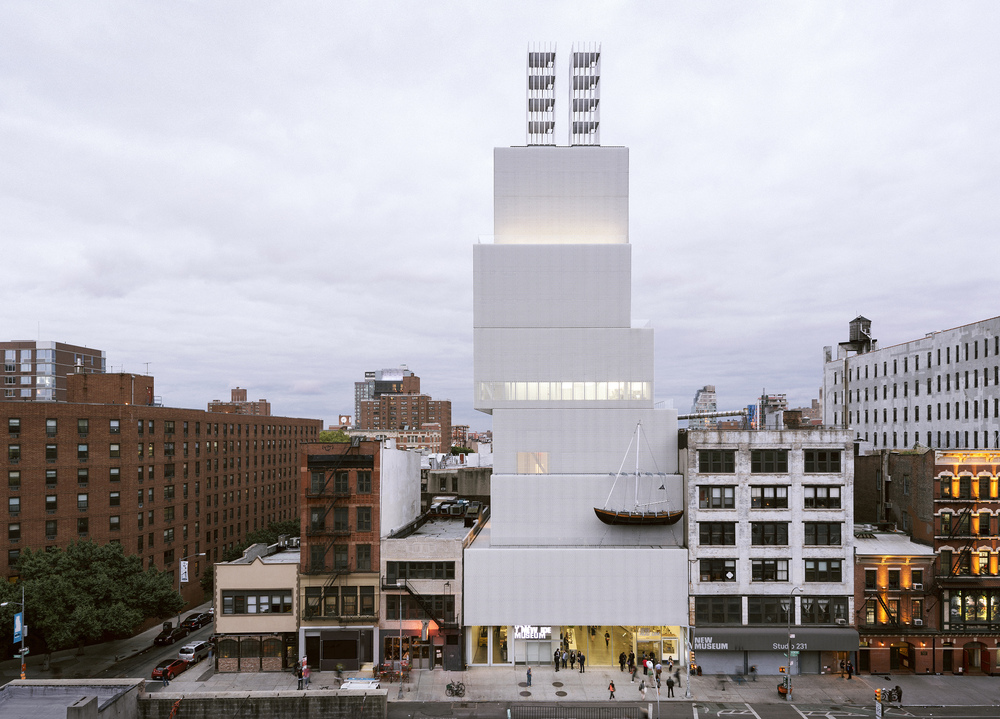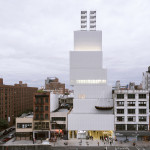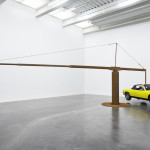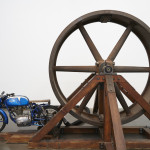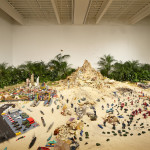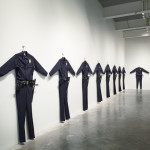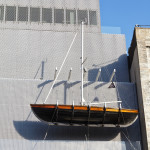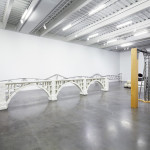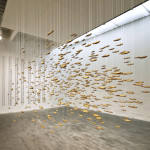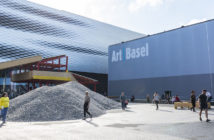Chris Burden's public persona has maintained a quirky and exceptional position within the art world since his 1971 performance of Shoot when he set up a situation in which he was shot in the arm at medium range with a 22-caliber rifle. In his first major survey in New York, Extreme Measures at the New Museum, a video documenting this work is included along with a selection of many of his other signature works such as The Big Wheel (1979) and A Tale of Two Cities (1981). What is remarkable about Burden's earlier performances, well documented in the show, was how amateur and succinct they were. In contrast, many of the later works presented here were grand in scale, execution and professional polish. How the artist went from his edgy and ephemeral exploration of endurance performances, that often courted real death, to become a fabricator of rarified and monumental objects emerged as one of the big questions I continually asked myself while taking in the show. How does an artist of Burden's almost mythically extremist credibility maintain and extend his conceptual aesthetics within a formally evolving practice? The upshot of this line of thought naturally leads to how Burden's aesthetics interact with and interpret the larger evolving social situations that his work directly or indirectly addresses spanning his scruffy beginnings to his current art-star remoteness.
The New Museum’s architecture is a tough venue for an artist of Burden’s expansive definition, since its galleries are bisected by a central elevator and services core that forces a feeling of being backed up against and into walls and corners, and this sense is particularly evident when large-scale work is displayed. Burden did utilize the outside of the museum, cantilevering his full scale, computer-guided Ghost Ship (2005), over the first floor, as well as installing Twin Quasi Legal Skyscrapers (2013), two skeletal towers on the museum’s roof. Both of these gestures, however, seemed gratuitous, and somehow detached, in the larger scheme of the show and too archly representational of his reputation as an artist not afraid to skirt the brink of phenomenal, and often existential risk. Given the architectural constraints within the building, one was made aware of the artist's decision-making process in overcoming these limitations, while simultaneously being asked to gauge how he retained his work’s crucial alternation between aesthetic gravity and flippant affect. The most effective installation was on the fourth floor of the museum where Burden’s vintage Triumph motorcycle-powered Big Wheel (1979) and his meteor-counterbalanced sports car, Porsche with Meteorite (2013), physically face off. The vertical rotation of the big flywheel echoed the stasis of the lateral circle implied by the unevenly weighted car and meteorite. The quaint materiality of the old steel present in both pieces created an opportunity to reflect on cultural craftwork and its phenomenal implications. The vintage aspect of the Triumph and the Porsche lent a patina of generational pathos to each work, a specificity of temporal limitation, that played well against the artist’s empirical experiment with inertia, momentum, and cosmic alchemy (in the case of the meteorite) infusing the space with a kind of quotidian wonder. The fabrication of these pieces could be looked upon as integral to their meaning yet also secondary. Like Walt Whitman projecting his electric being into passersby, Burden is at his best (in his sculptural projects) when he plays on the brink of the cosmically contingent while in dialogue with the materialized desires of a particular cultural moment. He set his own standard of diacritical materialism first in his early edgy performances, and later in such works as Beam Drop (1984-2009), which is represented, like the earlier performances, in a fascinating documentary video on the museum’s fifth floor. Beam Drop consisted of the artist staging a massive wet-concrete cube set 10 feet into the ground, which was then punctured by 71 junkyard-collected I-beams dropped vertically from a height of 150 feet. The sculpture’s process was thrilling to watch as the hurtling beams pierced the setting concrete pool to settle in attitudes tracing their specific trajectories, weight and length. The extreme measures of Beam Drop could be felt, even through the filmic distance of the documentary. The phenomenal hit of this piece had the same weight as some of Burden’s riskier early performances. This sculpture was a seamless outgrowth and evolution of the artist’s aesthetic. In a way Burden’s own standard for this kind of tightrope walk between sublime beauty and existential danger is such a high one that one might forgive some of his subsequent efforts which beat a retreat to a more domestically sane and craft-oriented realm. But empathizing with the artist to this extent would do a disservice to his historical capacity to resonate as an important figure of viscerally lateral thinking within the (even now) staid formal categories and orthodoxies of the contemporary art world.
 Chris Burden
Chris BurdenA Tale of Two Cities, 1981
Two miniature cities with approx.. five thousand toys, sand, plants, boulders
800—1,200 sq ft (243.8—365.8 sq m)
Weight: Approx. 53,000 lbs
Orange County Museum of Art, Newport Beach
Photo: Benoit Pailley. Courtesy New Museum, New York.
Towards the middle of the 1980s Burden seems to have lost his nerve. Works such as A Tale of Two Cities and All The Submarines of The United States of America (1987), both installed on the second floor of the museum, test their rhetorical power against current events with vague political critique, rather than on any imminent phenomenological threat. These works see the artist as boyish hobbyist, pathetically attempting to reconcile a social powerlessness with an incremental, interior phasmagoria of representational form. In these works Burden substitutes the mathematical sublime for the terrible sublime but comes up short in the lessened wager. The mélange of toys in Tale and the meticulously crafted paper submarines of ATSTUSA do impart a charming pathos of lived materiality, but their tabletop scale (even though the incremental installations were large) and their childhood references fail to transcend a maudlin solipsism which Burden seemed to be able to avoid in his work previously. Despite such lessened aesthetic ambitions these works do radiate certain down-home warmth in their presentation and execution. Other works in the show, such as Pair of Namur Mortars (2013) and Mexican Bridge (1998) further explore the craft/hobbyist vein but without soliciting any tactile empathy in their fabrication. In fact, the third floor of the museum feels like an alcove in a museum to industry, rather than a contemporary art exhibit, and not in any interesting way. It was frankly disheartening to see such an obviously spirited artist lose his performative badge of courage to these bridge kits and model cannons.
The evolution of Burden’s career somewhat represents the course of an American and world culture once preoccupied with heavy metal materiality but now distracted by celebratory representations of the spectacular gesture. Burden’s artistic response to this changed world is one of reticent acceptance. His most recent work never transcends its representational dogma (war is bad, man as good builder, man as politically powerless), and that dogma, not ever strident in Burden, fails to ground the work’s phenomenal lack of presence. At a time when the contemporary art world seems to be swinging between the poles of Richard Serra’s feats of scale and weight and Marina Abramovic’s exploits of physical endurance, there can be little fascination for Burden’s sling-shot approach to his former status as a risk-taking giant. Rather than summing up the artist’s best legacy, that of an interrogator of the art gesture as existential index, the specific combination and choice of works in Extreme Measures presents an artist at the end of his symbolic rope with no phenomenal bridge to walk across toward any breathtakingly interesting future.
- “Chris Burden: Extreme Measures” at New Museum, New York, 2013 Courtesy New Museum, New York. Photo: Dean Kaufman
- Chris Burden Porsche with Meteorite, 2013 Restored 1974 Porsche 914 with 365-pound meteorite, steel frame Dimensions: 13 ft 6 in x 38 ft 9 in x 13 ft 6 in (4.1 x 11.8 x 4.1 m); Car: 3 ft 11 ½ in high x 13 ft 6 in long x 5 ft 4 in wide (1.2 x 4.1 x 1.6 m), Weight: 2,190 lbs; Meteorite: 15 x 17 x 15 in (38.1 x 43.2 x 38.1 cm), Weight: 390 lbs; Steel Structure: 13 ft 6 in x 35 ft x 6 ft (4.1 x 10.7 x 1.8 m); 5,025 lbs total Courtesy the artist Photo: Benoit Pailley. Courtesy New Museum, New York.
- Chris Burden The Big Wheel, 1979 Three-ton, eight-foot diameter, cast-iron flywheel powered by a 1968 Benelli 250cc motorcycle 112 × 175 × 143 in (284.5 × 444.5 × 363.2 cm) The Museum of Contemporary Art, Los Angeles Gift of Lannan Foundation Photo: Benoit Pailley. Courtesy New Museum, New York.
- Chris Burden A Tale of Two Cities, 1981 Two miniature cities with approx.. five thousand toys, sand, plants, boulders 800—1,200 sq ft (243.8—365.8 sq m) Weight: Approx. 53,000 lbs Orange County Museum of Art, Newport Beach Photo: Benoit Pailley. Courtesy New Museum, New York.
- Chris Burden L.A.P.D. Uniforms, 1993 Wool serge, metal, leather, wood, plastic, Beretta handguns 88 × 72 × 6 in (223.5 × 182.8 × 15.2 cm) each Marion Boulton Stroud, Philadelphia, and Chris Burden in collaboration with the Fabric Workshop and Museum, Philadelphia Photo: Benoit Pailley. Courtesy New Museum, New York.
- Chris Burden Ghost Ship, 2005 Thirty-foot handmade sixareen sailboat, aluminum mast, computers and software, hydraulics, GPS system, auto rudder, and rigging Dimensions: Without mast: 6 ft × 8 ft 6 in × 30 ft (1.8 × 2.6 × 9.1 m) Mast: 30 ft high (9.1 m) Weight: 4,000 lbs Courtesy the artist and Gagosian Gallery Photo: Benoit Pailley. Courtesy New Museum, New York.
- Chris Burden Mexican Bridge, 1998 Three Arch Dry Stack Bridge, 1/4 Scale, 2013 Pair of Namur Mortars, 2013 “Chris Burden: Extreme Measures” at New Museum, New York, 2013 Courtesy New Museum, New York. Photo: Benoit Pailley
- Chris Burden All the Submarines of the United States of America, 1987 625 miniature cardboard submarines Installed: 8 × 20 × 12 ft (2.4 × 6.1 × 3.6 m) Each submarine: 2 × 8 × 1 in (7 × 21 × 3.8 cm) Dallas Museum of Art purchase with funds donated by the Jolesch Acquisition Fund, The 500 Inc., the National Endowment for the Arts, Bradbury Dyer, III, Mr. and Mrs. Bryant M. Hanley, Jr., Mr. and Mrs. Michael C. Mewhinney, Deedie and Rusty Rose, and Mr. and Mrs. William T. Solomon
Chris Burden: Extreme Measures was on view at New Museum, New York, October 2, 2013 through January 12, 2014
www.newmuseum.org
Some works are partially on view until January 26th.

